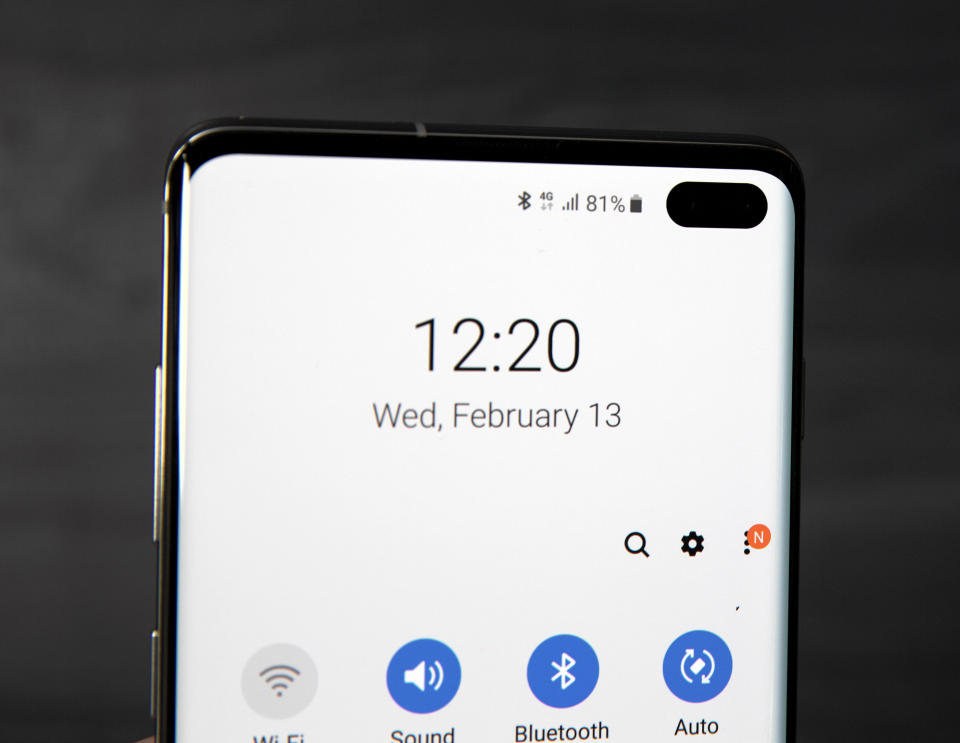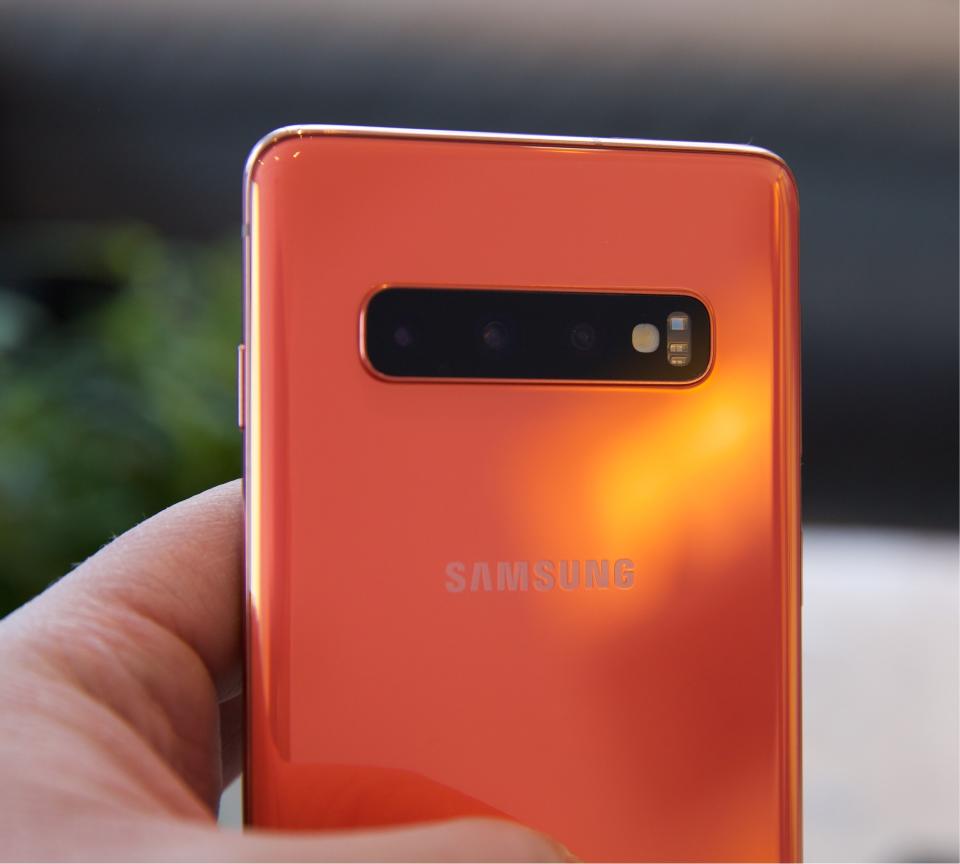Samsung's Galaxy S10 smartphones are here to take on the iPhone XS
Samsung debuted its first Galaxy S smartphone 10 years ago. And it, uh, wasn't great. There were multiple versions of the same phone depending on which carrier you purchased it for, which meant you might miss out on features like a front camera if you chose (Yahoo Finance parent company) Verizon (VZ) over Sprint (S).
But the company has come a long way since then. Not only is it among the best handset makers, but it's also the largest phone maker in the world. Which brings us to Samsung's newest offering: the highly anticipated Galaxy S10.
Available for pre-order Feb. 21 and hitting store shelves March 8, the Galaxy S10 will be available in three variants, the S10e, S10. and S10 Plus. Each phone packs a long list of impressive features, but as smartphone sales continue to flatten, it will be interesting to see if they will be enough to boost Samsung's sales numbers.
Galaxy S10e
Starts at $749
5.8-inch, edge-to-edge screen
2 rear cameras, 1 front camera
Fingerprint reader on power button
Galaxy S10
Starts at $899
6.1-inch, edge-to-edge screen
3 rear cameras, 1 front camera
In-display fingerprint reader
Galaxy S10 Plus
Starts at $999
6.4-inch, edge-to-edge screen
3 rear cameras, 2 front cameras
In-display fingerprint reader
Three for all
Like Apple, Samsung's new line of S10 devices are meant for three different kinds of shoppers. The S10e, like Apple’s (AAPL) iPhone XR, is for cost-conscious consumers. At $749, it has the lowest price tag, but is missing a handful features found on its pricier stablemates.
The $899 S10 is aligned with Apple's iPhone XS and is geared toward mainstream smartphone buyers looking for a lot of power without breaking the bank. And then there is the giant S10 Plus. Priced at $999, the S10 Plus falls in with the iPhone XS Max, and gets all of the best features Samsung cooked up for its latest generation of devices.
The S10e is also the smallest of Samsung's new handsets, packing a 5.8-inch, flat display. That means its panel doesn't have the same kind of curve as the S10 or S10+ on its left or right edges. And, aesthetically, it's better for it. The S10, meanwhile, gets a 6.1-inch screen, and the S10 Plus gets an enormous, 6.4-inch panel.
Size aside, the S10 series' most distinctive feature is the hole punch-style opening in the top right corner of the phones' screens that houses their front cameras. Samsung calls this its Infinity-O display, and it's rather eye-catching. The company has used the styling on other phones before, but this is the first time it’s showing up on a flagship smartphone.

The hole punch is Samsung's way of adding a front-facing camera to its smartphone without having to include a notch at the top of the handset like the one found on the iPhone. It's a quirky solution that's certain to get people's attention. The S10e and S10 only have single front-facing cameras, so their hole punch is just a small circle. But the S10 Plus gets a kind of oval-shaped hole thanks to its two cameras.
I was only able to demo the handsets for a brief period of time, so I can't say if the look interferes with things like full-screen videos. But I'll be sure to take note during my full review.
As far as general styling, the S10e, S10, and S10 Plus are all quite attractive smartphones. Their edge-to-edge screens and the glass in their rear panels combine to make the handsets every bit the flagships they are meant to be.
Unlike Apple, Samsung isn't ready to give up on the trusty fingerprint reader as a means to unlock your device. So where are the fingerprint readers if virtually all of the S10 lines' front panels are dedicated to screen space? Well, the S10e gets a reader built into the power button on its right side. The idea is that the reader is easy to reach with your thumb for quick unlocking.
The S10 and S10 Plus, however, get ultrasonic fingerprint readers embedded in their screens. The readers detect your digit quickly, but you have to make sure you tap your finger at their lower edges. I'll have to see how natural this motion feels when I spend more time with the S10.

In any case, both types of fingerprint readers end Samsung's use of rear-mounted readers, which were an absolute pain and caused you to inadvertently smudge your phone's camera lens.
Brighter screens, more cameras, more power
The S10 series marks the first time Samsung is using its new Dynamic AMOLED display technology. The company says the new screens are brighter than its older AMOLED panels and are HDR10+ certified. That's Samsung's proprietary HDR standard, which means you'll see more vibrant colors and deeper blacks.
Interestingly, Samsung says its panels reduce the amount of blue light you see, which can cause eye strain and disturb sleep. I'll have to put the S10 next to last year's S9 to see if there's any actual difference in what you see, when I get my hands on a review unit.
Not content with strapping two cameras to the back of its previous phones, Samsung is upping the ante for 2019 by adding three cameras to the rear of its handsets. Both the S10 and S10 Plus now feature an ultra-wide angle lens, a wide-angle lens, and a telephoto lens. Switching between the three in the camera app is as simple as pinching to zoom in or out.

The S10e, on the other hand, gets just two lenses, an ultra-wide angle and wide angle lens. You can still zoom with the S10e, but it will use software to give you a better look at your subject rather than a physical lens.
In terms of performance, the S10e, S10, and S10 Plus all come equipped with Qualcomm's (QCOM) latest Snapdragon 855 processor. The S10e is available with 6GB of RAM and 128GB of storage or 8GB of RAM and 256GB of storage. The more RAM, the more responsive a phone is likely to be. That said, 6GB is a heck of a lot of RAM for a smartphone as it is.
The S10, meanwhile, gets 8GB of RAM in both its 128GB and 512GB versions. The S10 Plus also gets 8GB of RAM for both its 128GB and 512GB versions, but if you go for the top-of-the-line variant with 1TB of storage, you'll get a whopping 12GB of RAM. I'm not quite sure who needs that much power, but, hey, why not?
The S10e also gets a 3,100 mAh battery, while the S10 gets a larger 3,400 mAh unit. The S10 Plus, for its part, gets a 4,100 mAh power plant. Each of the phones includes wireless charging, and can even be used to charge other devices wirelessly. In a demo, a Samsung rep used the S10 to wireless charge a dead iPhone.
Samsung's Galaxy S10 needs to be a hit if the company is going to continue to stand out as a smartphone leader. The company reported slower than usual sales of the S9, and it can't afford a repeat. I'll see if the S10 has what it takes in my upcoming review. Stay tuned.
More from Dan:
Email Daniel Howley at [email protected]; follow him on Twitter at @DanielHowley. Follow Yahoo Finance on Facebook, Twitter, Instagram, and LinkedIn.www.cerveza-artesanal.com/
